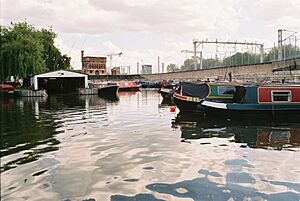St Pancras Basin facts for kids
The St Pancras Basin, also called the St Pancras Yacht Basin, is a special part of the Regent's Canal in London. It's located in the London Borough of Camden, just a little west of St Pancras Lock.
This basin used to be known as the Midland Railway Basin. Today, the Canal & River Trust owns it. Since 1958, it has been the home of the St Pancras Cruising Club, a club for boaters. The area around the basin is changing a lot because of big building projects linked to King's Cross Central.
Contents
What's Around St Pancras Basin?
The area around St Pancras Basin has some very interesting old buildings that have been moved and given new life.
Gasholder No. 8: A Park in a Frame
One cool structure near the basin is Gasholder No. 8. It was built in 1883, but its tank is even older, from the 1850s! The metal frame that holds the tank was the last one designed by John Clark.
This gasholder was once part of the Pancras Gasworks, which was the biggest gas factory in Britain in the 1860s. It used to be about 400 meters (440 yards) south of where it is now. The gasworks stopped making gas in the early 1900s.
Gasholder No. 8 became a special protected building (called a Grade II Listed structure) in 1986. It was used to store gas until the 1990s. When St Pancras railway station was being rebuilt, the gasholder was taken apart and then put back together in 2014 on the north side of the canal.
The gasholder frame has 16 hollow cast iron columns, each about 24 meters (80 feet) tall. These columns are connected by two levels of metal beams. Now, a park has been built inside this old frame! Footpaths connect the park to the canal towpath, which is a path next to the canal. There are also plans to build a new bridge over the canal.
Other Gasholders: Homes with Roof Gardens
Three other gasholders, numbers 10, 11, and 12, were also moved and rebuilt near the canal. These date from 1860 to 1867. They were made bigger in 1879-1880 and connected together.
Their hollow cast iron columns are linked by three levels of metal beams. These frames were carefully fixed up by a special company before being put back together. Now, each gasholder frame surrounds a round apartment building, complete with a garden on the roof! The architects WilkinsonEyre designed this amazing project.
St Pancras Waterpoint: A Moving Tower
A Grade II Listed watertower, designed by Sir George Gilbert Scott (who also designed St Pancras station), was built around 1870. This tower has also been moved to a new spot overlooking the basin.
It was built in a Gothic Revival style, which was a bit unusual for a practical building like a watertower at the time. The tower is mostly made of brick and used to hold about 62,700 liters (13,800 imperial gallons) of water. This water was used to supply steam trains on the Midland Railway.
The tower was moved from a site about 600 meters (660 yards) further south in late 2001. This was done to save it from being knocked down during the building of the Channel Tunnel rail link. Because the mortar (the cement between the bricks) was stronger than the bricks themselves, they couldn't just take the building apart brick by brick.
Instead, they cut the tower into three sections by sawing through two lines of bricks. The top two sections, which included the water tank and the first floor with its arches, were lifted by a crane and moved to the new site. The bottom part of the tower couldn't be moved because it was already damaged and part of a nearby bridge wall.
New foundations were built, and a new bottom section was made using bricks from Leicestershire, similar to the original ones. The moving of the 140-tonne sections happened over three days in November 2001. This building, now called St Pancras Waterpoint, will first be used as a viewing tower. Later, there are plans for it to be used for learning and fun activities.


